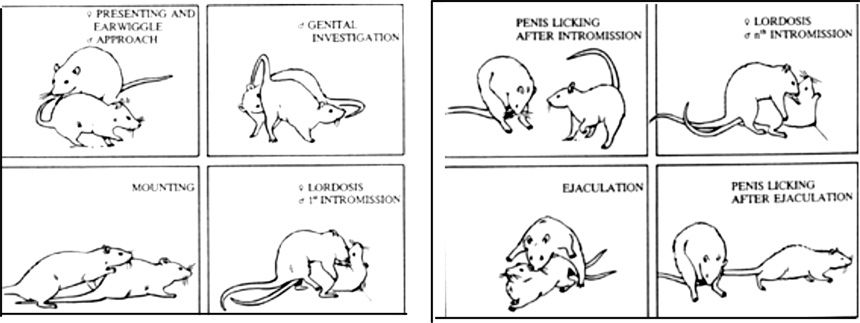
Made by Dirty Pomelo. Think that.(Talk about gender&society)
What can I learn from watching Rats having sex? The regular context of the study of biological differences (DP·G&S-31)
Today is the final part of the gender section of Gender and Society, Science. In this article, I want to study the objectivity and social and cultural background of science together with you. Let’s take a look at what kind of scientific rules and social and cultural context the research on biological differences has been carried out so far. . What do we need to think about this? We start with the part we think less about—sexual behavior, and think about whether there are gender differences in the name of science that we have never thought about.
1 Fragile objectivity
The core of modern scientific practice is objectivity. This objectivity is the most important driving force behind the success of modern science, that is, the success of human reason that can explain the world.
In addition, this objectivity is a huge incentive for the epistemological authority of scientific knowledge and for the popular acceptance of the trustworthiness of knowledge produced by such practices. The core objectivity of this modern scientific practice is based on the method of value-free observation and experimentation. But under the stress of this experimental approach, the "choice of the problem" part doesn't know where to go.

Feminist philosopher of science Sandra Harding criticizes,
The tendency to emphasize methodological objectivity without reflecting on the choice of these issues is " fragile objectivity " (Harding, 1986)
Any scientific activity cannot get rid of the social value system, but natural science is often only a method that emphasizes value neutrality and objectivity, and does not allow criticism of the basic assumptions in practice, which is as rigid as dogma in the end.
2 From Shushu's sexual position, we can see our thinking
Let's look at the importance of the "question of choice" through the example of sexual behavior research.
Sexual behavior studies, carried out extensively in the 1960s, often used rodents to observe the behavior of males and females in mating scenes. Scientists have defined male and female sexuality differently. (Wijngaard, 1994)

Male behavior is thought to be very complex, including crawling, penetration, ejaculation, and combinations of these behaviors, whereas female sexual behavior appears to be simply a Lordosis behavior (Lordosis behavior, also known as mammalian lordosis (Greek lordōsis, From lordos "bend backwards") is a naturally occurring body position, such lordosis is a reflex action.

Many non-primate female mammals adopt body positions that are often critical to reproductive behavior. The pose tilts the pelvis forward, lifts the back of the pelvis up, tilts the bottom back, and tilts the front down. The lordosis aids in copulation because it elevates the hips, which facilitates penis insertion. Similar to the locomotor action, cat stretch), the degree to which the back is bent is considered a measure of fitness in females.
Many people will bring understanding based on some social or personal experience.
but,
The lordotic behavior is non-functional in humans, although a similar spine can be observed from Retro-entry Pose (There are many forms, but often one side prostrates, hips raised. Similar to Triangle Pose in yoga.) lordotic posture.

In a 2017 study, using 3D models and eye-tracking technology, it was shown that a slight protrusion of a woman's buttocks affects how attractive she is to others and attracts the gaze of both men and women. the author thinks
"While human females do not exhibit a reflexive lordotic posture and receptive sexual behavior is not passive or coercive to them, the manifestation of lumbar curvature may be a signal of receptive/receptive communication between males and females remnants".
Here we refer to the natural movement of the female singer Lisa turning her head when she walks.

Previously, anthropologist Helen Fisher Helen Fisher also speculated that,
When human women wear high heels, their hips straighten and their backs arch, a posture that mimics lordosis, which is why high heels are considered "sexy."
Nonetheless, recent evidence has extended the influence of lordotic posture beyond standing posture and high-heeled shoes, as it suggests that women's quadruped and supine standing postures signal sexual receptivity.
See also the example of men here.

Let's go back to the previous experiment on rats. The experimental model at that time also reflected the ideas of scientists at that time. When the scientists conducted the experiment, after the male rats were transferred from the original cage to the experimental site, it took about 2 hours to adapt to the new situation. Experiments were also started after the male rats had passed this acclimatization period before adding female rats.
As shown in this experimental model, sexuality has achieved an "androcentricity - a matter of choice", and females are only a means of observing male sexuality.
This male-biased experimental method was first paid attention to female sexual behavior by female scientist Monica Schoelch-Krieger at a meeting in 1970, and a series of experiments were objectively tested by the scientific community accepted.
Monica Schoelch-Krieger restrained male rats and gave female rats the chance to respond to the males. Female rats transferred from their cages to the experimental field were initially confused and disorientated, displaying highly diverse and complex behaviors in addition to their forward spines. Female rats run back and forth, dash, jump, and move their ears. This was the choice of questions governing the study of sexuality at the time, which was not anticipated in the androcentric definition of sexuality.

It is said that this announcement had a huge impact on the audience, and the presentation scene of the academy was also thrown into chaos. Since then, female sexuality has been the subject of new research. By observing the sexual behavior of mice, the paradigm of human scientific knowledge exploration has been shifted. Moreover, taking into account the sexual behavior of females, the category of sexual behavior begins to include elements that were not there before.
For example, female and male interactions, such as sexual arousal, exploration, pre-mating sex, etc., are included in the important stages and types of sexual behavior. (Wijngaard, 1994)
3 How a problem becomes a problem
Harding regards the "problem of problem selection" as "value-neutral objectivity with one eye open and one eye closed" as "weak objectivity", that is to say, there is an opposite "strong objectivity" (Harding, 1986) because strong objectivity amplifies researchers' biases, which Harding argues can never be truly eliminated.
(Strong objectivity is a key concept in Sandra Harding's version of stance theory, which puts knowledge in a social context into practice. In contrast to traditional models of value-neutral objectivity, strong objectivity insists that researchers critically Examining the role of social conditions in knowledge formation, uncovering contextual assumptions and cultural agendas. It offers methodological advice for researchers to "think from marginalized lives".)

Knowledge research activities will inevitably be affected by specific cultural backgrounds, and research that attempts to conduct rigorous reflection on all value systems is the strong objectivity that maximizes the objectivity of knowledge. In the previously observed cases, how does modern science respond to the relative numerical values of cephalology and to the cross-discovery of sex hormones?
Because the practice of modern science itself is "problem selection", that is, there is no requirement to reflect on the concept of dichotomy and differentiation, so compared with re-studying the previous standard even if there is a problem, you have to choose the problem", but Re-look for other ways to prove that the dichotomy is poor.
That is, to address within the bounds of thin objectivity. In the history of sexual behavior research, Monica Schoelch-Krieger's new study does more than just change the methodology. It is through the re-examination of "problem selection" that the major transformation from the existing male-centered "problem choice" to female-centered is realized.
When we come into contact with scientific knowledge of sexual differences, what we need to pay attention to is this "problem selection", that is, what kind of social and cultural background is the production and expansion of this knowledge and its acceptance by the public. Scientific knowledge produced and received in egalitarian societies differs markedly.
Only when people are able to recognize and reflect on this bias called "traditional thinking" can we gain insight into the complex realities of biology and society.
Following the perspective of anthropology and scientific epistemology, we will continue to think from the perspective of social culture.
Learn with Dirty Grapefruit.

Ref:
Van Den Wijngaard, M. (1994). Feminism and the biological construction of female and male behavior. Journal of the History of Biology, 61-90.
Sachs, Benjamin D., et al. "Sexual behavior: normal male patterning in androgenized female rats." Science 181.4101 (1973): 770-772.
Elizabeth Hawkins (October 25, 2017). "Why arched backs are attractive". springer.com.
Pazhoohi, F.; Doyle, JF; Macedo, AF; Arantes, J. (2017). "Arching the Back (Lumbar Curvature) as a Female Sexual Proceptivity Signal: an Eye-Tracking Study". Evolutionary Psychological Science. 4 (2 ): 1–8. doi:10.1007/s40806-017-0123-7. S2CID 149046079.
Laura T. Coffey (Sep 23, 2009). "Do high heels empower or oppress women?". TODAY. Archived from the original on September 26, 2009. Retrieved November 1, 2021.
Pazhoohi, F.; Garza, R.; Kingstone, A. (2022). "Sexual Receptivity Signal of Lordosis Posture and Intra-Sexual Competition in Women". Sexes. 3 (1): 59–67. doi:10.3390/sexes3010005 .
Like my work?
Don't forget to support or like, so I know you are with me..
Comment…